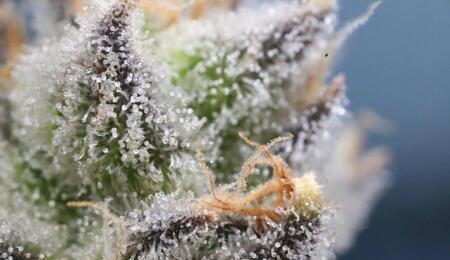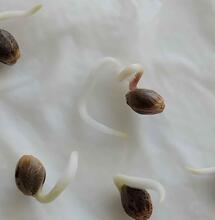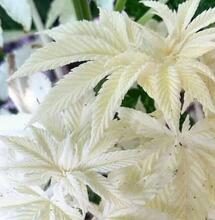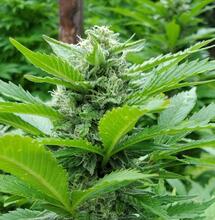Cannabis Terpenes: The Secrets to a More Aromatic Harvest

We all want our buds nice and smelly. Taste and aroma are key properties to help distinguish one cannabis strain from another.
You may enjoy a bud of Mr. Gelato Ice for its heavy stone and the relaxing, happy effect it gives, but also for its potent citric and floral aroma with an earthy aftertaste finish. Or, you may enjoy a boost of cheerfulness from smoking Orange Juice, and further appreciate it for its sweet orange, tangerine-like taste and smell.
The secret to why cannabis strains have compelling smells and tastes is terpenes. Luckily, you can take advantage of several gardening tips to ensure nugs are giving you a real aromatherapy experience while making you high.
Cannabis Terpenes: What are they and how do they deepen our appreciation of being high?
Cannabis terpenes are aromatic compounds that are generated simultaneously with cannabinoids such as CBD and THC. Thanks to terpenes, cannabis emits its distinctive odor; it's what helps us distinguish between different kinds of strains.
The development of cannabis terpenes has been associated with the environmental adaptation of the cannabis plant, helping the plant to attract pollinators while protecting it from grazing animals. A number of factors can influence cannabis terpenes, including local climate, sun and rain, the time of day (morning or night), or the soil where the plant is growing.
More than a hundred of different terpenes have been found in cannabis plants, with each strain boasting a genuine terpenes combination. The cannabis industry has been fairly busy with utilizing terpenes for various commercial strains, but also for tinctures, vaping oils, lotions, edibles, and beverages.
One of the reasons why a popular strain such as Sensi Star stands out from other strains is its unique, distinctive scent. Sensi Star is a remarkable Indica, created by Paradise Seed; its smell is an enticing mix of spicy, lemon with a touch of metallic that can be felt on the tongue all while your nostrils perceive a scent of squeezed lemon and fresh pine. In its aftertaste, Sensi Star reminds of black pepper and a nice women’s perfume. So, smoking Sensi Star does not only give you an awesome sensation of high but a rich aromatic experience as well.
The primary terpene of Sensi Sar is Myrcene, which is common in bays, hops, mango, and lemongrass. Myrcenes are quite frequent in other strains, too. For instance, it’s found in strains of Cherry Pie and OG Kush. It is the terpene that gives the earthy quality smell of weed, and it’s associated with having relaxing and stress-reducing characteristics. Sensi Star is a perfect strain to take for relaxation, and it’s safe to say its Myrcenes contribute to that sensation.
Another important terpene present in Sensi Star strains is Limonene. With its refreshing, citrus-like fragrance, Limonene is commonly used in perfumes. This terpene is recognized for having pain relief qualities, and it acts as a strong antioxidant. It binds perfectly with terpenes such as Myrcene.
What gives the spicy and peppery fragrance of Sensi Star is a third terpene called Caryophyllene, which is also present in various plants we use for eating. Caryophyllene boosts some anti-inflammatory qualities, and it is thought to reduce the desire to drink alcohol. Many recreational users do take weed and alcohol together, however, this combo does not always give the best effects. In addition to Myrcene, Limonene, and Caryophyllene, a strain such as Sensi Star contains other terpenes such as Alpha Pinen and Beta Pinen (pinens are found in pine, basil, and rosemary), Terpinolene (found also in lilacs and nutmeg), and Linalool (present in lavender and birch) amongst other. And this is the example of terpenes diversity in just one single strain.
While we know that terpenes help cannabinoids such as THC to promote the effects of individual strains, more research is needed to obtain other important information about them.
How to boost terpenes when growing cannabis at home?
There are several things you can do while homegrowing to get a boost on the aromatic qualities of your cannabis plants. First and foremost, you need strains that are known for their flavorful and nice-smelling qualities, such as Sensi Star dissected above or perhaps Orange Haze, which has a super enticing aroma of sweet citrus, and a delicate allure of both orange and sweet at the end. Then, make the most of the tips below and aim for a flavorful, aromatic yield.
Tip #1: Use soil, and nourish plants solely with water prior to harvest
No matter if you are growing weed inside or outside, using high-quality soil can be determinative to cannabis plants that give truly flavorful buds. So, use soil as a medium when you target growing aromatic buds.
There’s a great advantage when you grow in soil as you are able to super-enrich the soil with nutrients that will soothe the plant, just like you would other plants in your garden. You can use compost, molasses, kelp, worm castings, and fish hydrolysate or combine altogether to use as compost tea for your cannabis plants. It’s also important to know when to stop administering nutrients. Two weeks ahead of harvesting would be a suitable time to switch nurturing the plants with water only. By this point, the plant’s colas should have enough reserves of nutrients. If you overdo nutrients, it may lead to an excess of nutrients that will in turn alter the natural flavors of the plant. Using water during this last stage of growth will ensure the buds retain their natural aromatic qualities.
Tip #2: Optimize the plant’s exposure to light
Ideally, to yield some extra flavorsome weed, plants require direct exposure to the sun. That is if you are growing outside. If your plants are growing indoors, you have to ensure there is enough distance between each plant, and that each cola absorbs as much light as possible. If you are growing in limited space, this might be a little bit of an issue.
Tip #3: Conduct some low-stress training
Training the cannabis plants can help its trichomes production, hence the production of terpenes as well. You can prune some of the lower branches of the plant during the flowering stage as this will help other flowers obtain more energy and increase their trichomes volume. Low-stress training can be combined with other efforts such as exposing the cannabis plants to slightly colder-than-usual temperatures during the night. However, always observe your plants carefully. You don’t want to overdo stress training, as it can damage crops irreversibly.
Tip #4: Handle the buds gently when harvesting
When you collect the buds, perform this operation gently. Trichomes are delicate, so treat the buds as such. Remain gentle with them until they are properly cured. Do your buds another favor and don’t change their location too often after harvest. One more thing is that you definitely don’t want mature buds to remain on the plant more than they need to. A timely harvest is essential, as otherwise, trichomes may start breaking down and undergo a chemical decomposition. That, by default, changes the cannabis terpenes, too.
Tip #5: Properly curing your buds is one last key step
You may want to try your freshly grown weed as soon as possible. However, to experience the optimal smell of each strain, it’s best to let those nugs rest and dry in order for all terpenes to preserve. Keeping the buds away from light, with room humidity of around 50%, and where the temperature is on the lower side, should secure some key conditions for optimal curing. When you follow these steps during growing and harvest, your buds will certainly give you more delight in terms of flavor. You will be able to boost terpenes in your cannabis and make other homegrowers jealous of the taste and smell of your buds.



